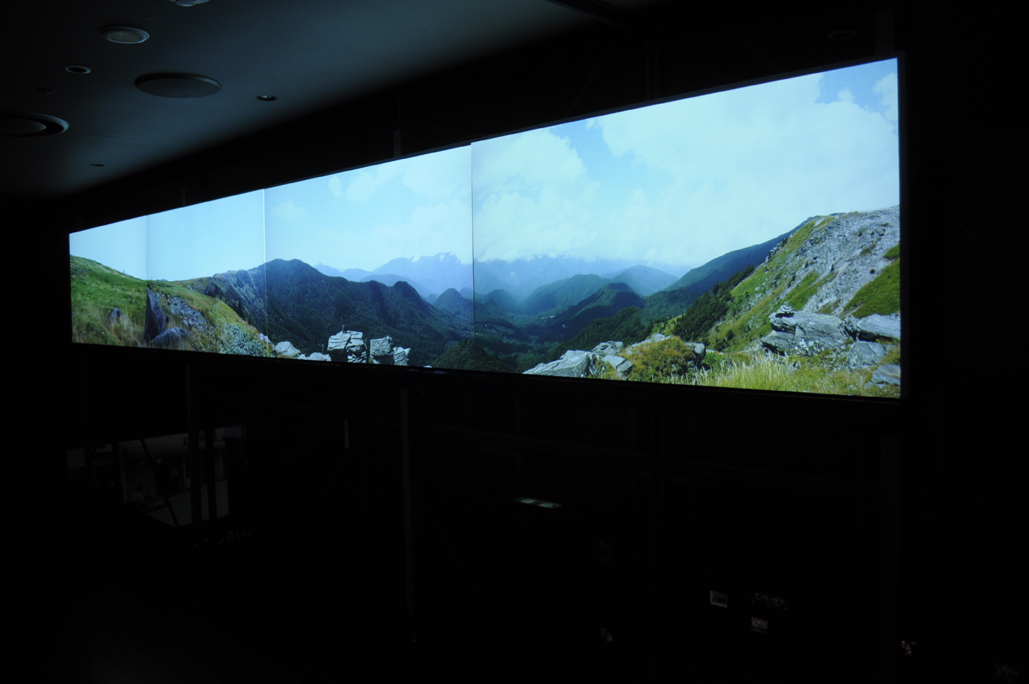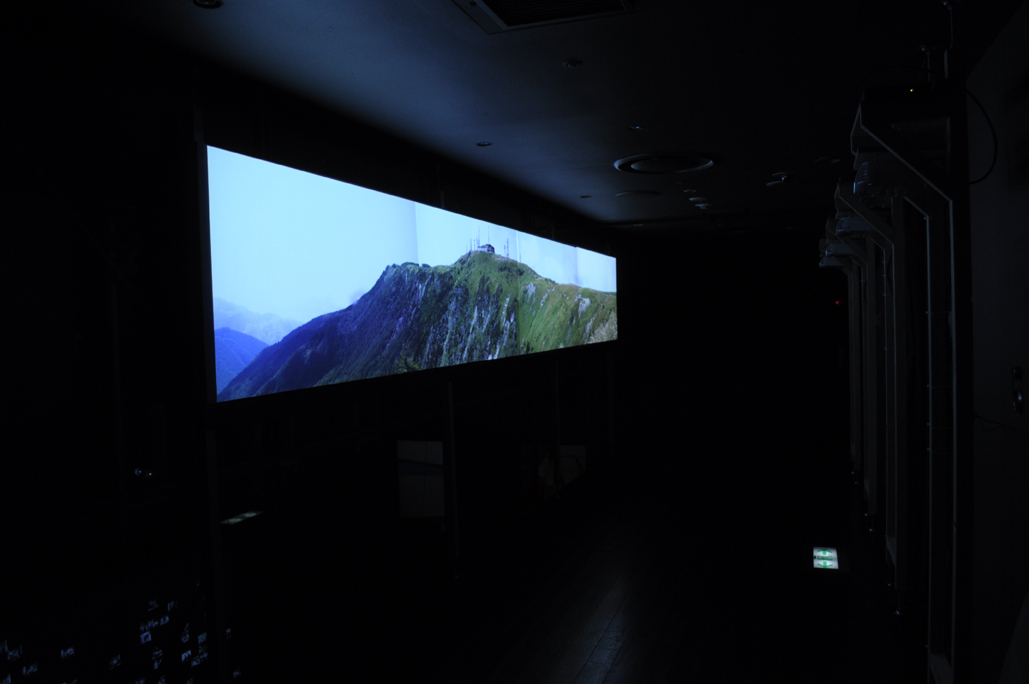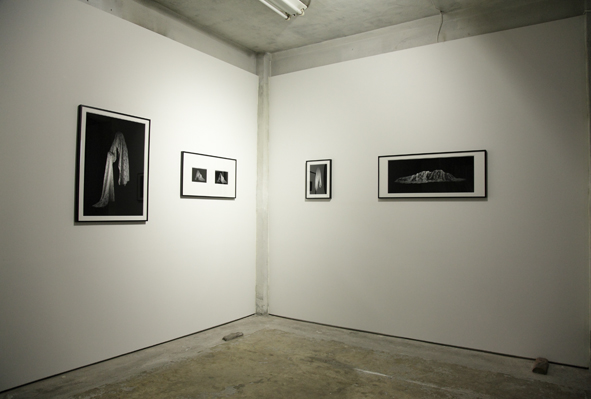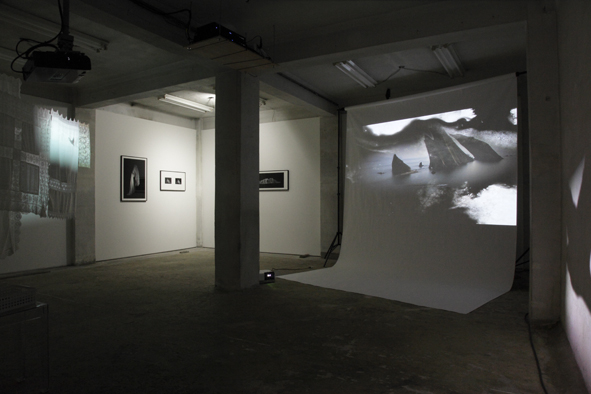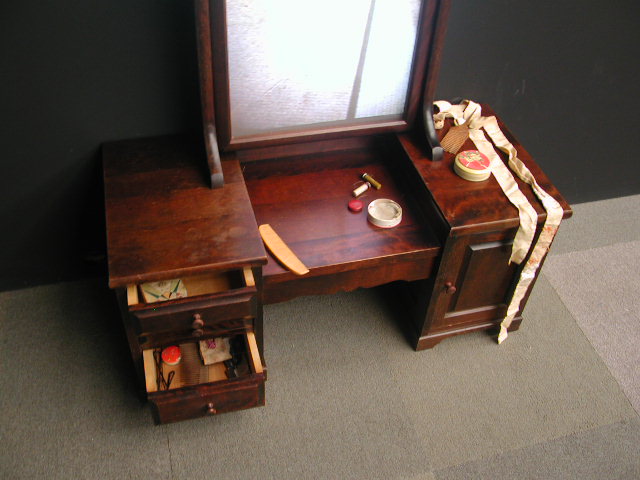 2012
2012 Video Installation
Video InstallationQuickTimeMovie 33min.(endless repeat), color, silent
exhibition
This work is the first collaboration project with Artist Takayoshi Tsuchiya.
This work has a very long and narrow structure (final width is 180,000 pixels. ) like a picture scroll (Emakimono), and has moving time by scrolling slowly.
sample movie
 2011
2011 Photographs
PhotographsGiclee & Movie, BD 1min.(endless repeat), color, silent
exhibition
 2011
2011 Video Installation
Video Installation BD 22min.(endless repeat), color,sound
exhibition
- 2011 "The Darkness and The Bird, The Ashen Shadow", Yuka Sasahara Gallery, Tokyo
- 2011 "2.46 and Thereafter", Edison Place Gallery, Washington DC, USA
- Naoko Seki “Gazing at Something in the Dark” (review), Bizyutsu-Techo 2012/2
bibliography & article
Main Collection
Museum of Contemporary Art Tokyo
sample movie
 2008
2008 Video Installation
Video InstallationBD 10min.(endless repeat), color,silent
exhibition
- 2008 "Self and Other :Portrait from Asia and Europe", The National Museum of Ethnology・The National Museum of Art, Osaka・The Fukuoka Asian Art Museum・The Museum of Modern Art, Hayama
bibliography & article
 2007
2007 Video Installation
Video InstallationBD 14min.(endless repeat), color,sound
exhibition
- 2007 "Miniature Garden", Yuka Sasahara Gallery, Tokyo [1] [2] [3] [4] [5] [6]
- 2007"Tradition and New Age -The Ink, a Monochrome World- "Former Sakamoto Elementary School of Taito Ward, Tokyo
- 2009 "2009 INTERNATIONAL INCHEON WOMEN ARTISTS' BIENNALE - So Close Yet So Far Away- " Incheon Art Platform、Korea
- 2009 "Yebisu International Festival for Art and Alternative Visions", Tokyo Metropolitan Museum of Photography, Tokyo
screening
bibliography & article
- "Tradition and New Age -The Ink, a Monochrome World-"(Catalog), Tokyo National University of Arts & Music 2007
- “Yebisu International Festival for Art and Alternative Visions”(Catalog), Tokyo Metropolitan Museum of Photography 2009
sample movie
 2006
2006 Video Installation
Video InstallationDVD 5-23min.(endless repeat), color,sound
exhibition
- 2004 "Flowering Plants of the Four Seasons -spring-", ASK? art space kimura, Tokyo [1]
- 2004 "eco&ego" Former Shibazaki Residence, Kawaguchi City, Saitama Prefecture, Japan [1] [2]
- 2005 "Mirage on a Summer Day -Reflections on Nature by Contemporary Artists-", Gunma Museum of Art, Tatebayashi, Gunma [1] [2]
- 2005 "The country art exhibition in Ashigara", Former Seto Residence、Kanagawa
- 2006 "Projected Realities : video art from east asia", Asia Society and Museum, NY [1] [2] [3]
- 2006 "NIHONGA Painting : Six Provocative Artists", Yokohama Museum of Art [1] [2] [3] [4] [5] [6] [7] [8] [9] [10]
- 2007 "East of Eden : Gardens in Asian Art", Freer & Sackler Galleries/Smithsonian, Washington [1] [2] [3] [4]
- 2008 "Yokohama Art & Home Collection", Yokohama Home & Art Collection, Kanagawa
- 2009 "Mind as Passion:A video art exhibition featuring 17 new-generation artists from Taiwan and Japan", Taipei Fine Arts Museum, Taiwan
bibliography & article
- "NIHONGA Painting : Six Provocative Artists (supplement)" (Catalog), Yokohama Museum of Art 2006[Comment]p.17[Photographs] p.18-20
- Daniel Kunitz "Asia's Digital Dimension"(Review),The New York Sun 2006 [Review/Photographs]
- "Mind as Passion:A video art exhibition featuring 17 new-generation artists from Taiwan and Japan"(Catalog), Taipei Fine Arts Museum 2009 [Comment]p.8-31/Liu Yung-Hao (Shin Hsin University), Jo Hsiao(Curator : Taipei Fine Arts Museum) [Photographs/Comment] p.102-105
Coment
-
"Flowering Plants of the Four Seasons"
- In the frames of “painting,” we transform natural forms including our body and see beauty in it.
- There I see our awe to unconscious nature and will to control the nature including our body.
- The deep and cold eye lurking in the painting is infiltrated into my film works as its peculiar texture.
- This work is based on Japanese traditional pictures -Flowering plants of the four seasons-. I takes pictures during the four seasons in Japan by digital camera. And, the audience can see various seasons and time in one frame.
- In this exhibition, I used fusuma (The screen to part each room in Japanese style house.) as frame which we see daily.
- I am fearing, but waiting to sit in front of it with the audience to see what odd and egoistic landscape will appear on it.
- Wrriten by Mami Kosemura
- "Screen Shots" East of Eden : Gardens in Asian Art, Smithsonian/Freer Gallery of Art and Arthur M. Sackler Gallery
- Mami Kosemura arranges the plants that she’s brought specially to her studio, a room in her house she shares with her husband on the outskirts of Tokyo. She’s reinterpreting a traditional painted Japanese multifold screen using digital photography and video, taking a time honored art form and, through the prism of new technology, turning it on its side. For Kosemura, who admires the animating effects of brushstroke in Japanese painting, Flowering Plants of the Four Seasons is the first time she’s referenced traditional Japanese paintings in her work. Before this, she’s gone to the European masters, such as Caravaggio and Zurbaran for her inspiration: she’s made the still-life move.
- For Flowering Plants, she’s chosen the flowers, the grasses, all the colors of the seasons, and brought them indoors to work. Many of the young plants she bought in neighborhood garden stores, planted them in clay flowerpots, and grew them herself, marking their growth by shooting a digital picture, every half hour or so.
- When the process is complete, the person who stands in front of her screen—a riff on the traditional Japanese screen that often depicts the four seasons—will see the year collapsed in on itself. Perhaps that’s why Kosemura offers this gentle warning to people standing before her installation, “Please look very carefully because video work contains both truth as well as non-truth.” Maybe seeing is not always believing. Time lapse has replaced linear reality, and the seasons come and go in the blink of an eye. The plants begin green, flower to color, then dry, fade, and disappear. The seasons change, the winds come, moving the plants and dispersing the seeds, so that what appears at first as decay, also holds the promise of future growth. In winter the snow comes and covers the landscape. “I don’t have a favorite season,” Kosemura says, “but snow does play an interesting part in traditional Japanese painting.” For winter, as well as for autumn flowers, she used a video camera to capture the images, then converted the video data into the photography format of the other seasons.
- The intersection between painting and video is nothing new for Kosemura who was born in Japan in 1975, and who studied painting, both oil and mural, at Tokyo National University of Fine Arts and Music. An earlier work, “Sweet Scent” was inspired by a still life by 17th century Spanish artist Francisco de Zurbaran. For several months Kosemura pointed her camera at an arrangement of fruit and a cup that she assembled to look just as if it came from the heart of the painting. Gradually, the fruit began to bruise, then rot, then decompose. “I also colored each image to look like a painting, and drew in it. The images formed by this method are documentary but also fictional,” Kosemura says, “In this way, the flowers and fruit pile change upon change in the name of "painting" so that even I, the maker, cannot distinguish whether a particular flower is real or fabricated. However, when one sees a video image one cannot help having a definite feeling of reality in the dying form of the fruit and the flowers.”
- Similarly, Decaying was Kosemura’s interpretation of a still life once attributed to Caravaggio. Again, Kosemura arranges the flowers and fruits to look as if the scene was copied from Caravaggio’s canvas. But now the viewer gets to see deeply into the objects as they decay over time. Most people glimpse at a painting in a museum, or stand before it for a few minutes for a hard look. Mostly, the paintings change us, the viewer. But for Kosemura that’s not enough: in her work, the image changes as well. Painting captures a moment in time, while video can capture many moments—a whole cycle of experience.
- That experience also includes an endless loop of sound. Flowering Plants of the Four Seasons was originally shown in an old house in Tokyo--the Shibazaki residence, Kawaguchi City, Saitama Prefecture—as part of a larger art installation. Every time Kosemura went to the house she noticed that the garden was filled with birds. “I often heard bird songs whenever I went there. I decided to choose this sound for the video so that the same sounds could be heard outside and inside the house.”
- Wrriten by Howard Kaplan (Asiatic ; Freer and Sackler Galleries/Smithsonian Institution)
sample movies
 2006
2006 Video Installation
Video InstallationDVD 8min.(endless repeat), color,sound
exhibition
- 2006 "NIHONGA Painting : Six Provocative Artists", Yokohama Museum of Art [1] [2] [3] [4] [5] [6] [7] [8] [9] [10]
bibliography & article
- "NIHONGA Painting : Six Provocative Artists" (Catalog), Yokohama Museum of Art 2006 [Explanation] p.9-10 / Tomoo Kashiwagi (Yokohama Museum of Art) [Photographs]p.44-51[Interview]p.78-81
- "NIHONGA Painting : Six Provocative Artists (supplement)" (Catalog), Yokohama Museum of Art 2006[Comment]p.17[Photographs] p.18-20
sample movie
 2006
2006 Video Installation
Video InstallationDVD 5.30min.(endless repeat), color,silent
exhibition
- 2006 "NIHONGA Painting : Six Provocative Artists", Yokohama Museum of Art [1] [2] [3] [4] [5] [6] [7] [8] [9] [10]
bibliography & article
- "NIHONGA Painting : Six Provocative Artists" (Catalog), Yokohama Museum of Art 2006 [Explanation] p.9-10 / Tomoo Kashiwagi (Yokohama Museum of Art) [Photographs]p.44-51[Interview]p.78-81
- "NIHONGA Painting : Six Provocative Artists (supplement)" (Catalog), Yokohama Museum of Art 2006[Comment]p.17[Photographs] p.18-20
sample movie
 2006
2006 Video Installation
Video InstallationBD 8min.(endless repeat), color,sound
exhibition
- 2006 "NIHONGA Painting : Six Provocative Artists", Yokohama Museum of Art [1] [2] [3] [4] [5] [6] [7] [8]
bibliography & article
- "NIHONGA Painting : Six Provocative Artists" (Catalog), Yokohama Museum of Art 2006 [Explanation] p.9-10 / Tomoo Kashiwagi (Yokohama Museum of Art) [Photographs]p.44-51[Interview]p.78-81
- "NIHONGA Painting : Six Provocative Artists (supplement)" (Catalog), Yokohama Museum of Art 2006[Comment]p.17[Photographs] p.18-20
sample movie
 2006
2006 Video Installation
Video InstallationDVD 5.20min.(endless repeat), color,silent
Artfair
- 2006 "ART @ AGNES" The Agnes Hotel and Apartments, Tokyo
sample movie
 2004
2004 Video Installation
Video InstallationDVD (multi‐channel) 8min.(endless repeat), color,silent
exhibition
- 2004 "MOT Annual 2004 -Where do I come from? Where am I going?-", Museum of Contemporary Art, Tokyo [1] [2] [3] [4]
- 2005 TAP2005 Satellite gallery Vol.2, "Suzuki Minoru + Kosemura Mami", TAP Satellite gallery, Ibaraki
- 2008 "NEW TOKYO CONTEMPORARIES" the New Shin-Marunouchi Building, Tokyo
- 2008 "Self and Other :Portrait from Asia and Europe", The National Museum of Ethnology・The National Museum of Art, Osaka・The Fukuoka Asian Art Museum・The Museum of Modern Art, Hayama [1] [2] [3] [4]
screening
bibliography & article
- "MOT Annual 2004 -Where do I come from? Where am I going?-"(Catalog), Museum of Contemporary Art, Tokyo 2004 [Explanation]p.15-17/Naoko Seki (Museum of Contemporary Art, Tokyo) [Photographs]p.58-65 [C.V.]p.93~94 p.97~98 [Bibliography]p.101 [1] [2]
- “Image Forum Festival 2005”(Catalog), Image Forum 2005 [Photographs]p.4 [C.V./Explanation]p.28
- "TAP2005 Satellite gallery Vol.2, Kosemura Mami"(Catalog)Toride Art Project Executive Committee 2005 [C.V./Explanation] Seiichi Tsuchiya (Art Clitic)
- "Self and Other :Portrait from Asia and Europe" (Catalog), The Asahi Shimbun Company 2008 [Explanation] p.17, p.23 / Kenji Yoshida (Professor, National Museum of Ethnology) [Photographs / Column] p.252~p.253, p.308
sample movie
 2003
2003 Video Installation
Video InstallationDVD 9.25min.(endless repeat), color,sound
exhibition
- 2003 "Sweet Scent",Futaba Gallery, Tokyo
- 2003 Vision's Program exibition, "Kosemura Mami + Sawanobori Kyoko", Vision's, Tokyo
- 2004 "MOT Annual 2004 Where do I come from? Where am I going?", Museum of Contemporary Art, Tokyo
- 2004 "Picture in Motion", Tochigi Prefectural Museum of Fine Arts, Tochigi
- 2005 "art on film − picture / film” Yokohama Art Museum , Kanagawa
- 2005 "EXiS2005" Seoul Art Cinema & space Cell , Korea
- 2005 "Experimental Cinema in Japan" Centre culturel la Clef , France
- 2007 "Animation - Adventures of "Moving Picture", Yokohama Museum of Art, Kanagawa
bibliography & article
- "Vision's Program exibition, Kosemura Mami + Sawanobori Kyoko"(Catalog), Vision's, Tokyo 2003 [Photographs/C.V.]
- Atsuo Sugawara "The changing self-existence"(review),The Yomiuri Shimbun 2004/2/5
- "MOT Annual 2004 -Where do I come from? Where am I going?-"(Catalog), Museum of Contemporary Art, Tokyo 2004 [Comment]p.15-17/Naoko Seki (Museum of Contemporary Art, Tokyo) [Photographs]p.58-65 [C.V.]p.93~94 p.97~98 [Bibliography]p.101 [1] [2]
- "Picture in Motion"(Catalog), Tochigi Prefectural Museum of Fine Arts 2004[Photographs/C.V./Comment]p.50-57/Kazuhiro Yamamoto(Tochigi Prefectural Museum of Fine Arts)
- "EXiS2005 CINEMA?CINEMA!"(Catalog)Experimental Film &Video Festival in Seoul Organizing Commiittee [Comment/C.V.]p.90
comment
- I subsequent work have been concerned with interactions between painting and video.Sweet Scent, which appears in this exhibition, resembles a still life by Francisco de Zurburan (1598-1664).
- I reproduced the arrangement of fruit and a cup in an interior found in the painting and photographed it every hour with a digital camera to document the changing condition of the fruit as it decomposed. This process was continued for several months, and I colored each image to look like a painting, and drew in it. Moreover, the shape of the object was transformed, and the images were edited on DVD.
- The images formed by this method are documentary but also fictional. In this way, the flowers and fruit pile change upon change in the name of "painting" so that even I, the maker, cannot distinguish whether a particular flower is real or fabricated. However, when one sees a video image one cannot help having a definite feeling of reality in the dying form of the fruit and the flowers. I want to examine this scene.
- Written by Mami KOSEMURA ["Picture in Motion"Tochigi Prefectural Museum of Fine Arts 2004]
- Mami KOSEMURA (1975-)studied oil painting and mural painting, and her subsequent work has been concerned with interactions between painting and video.
- Sweet Scent, which appears in this exhibition, resembles a still life by Francisco de Zurburan (1598-1664).
- Kosemura reproduced the arrangement of fruit and a cup in an interior found in the painting and photographed it every hour hour with a digital camera to document the changing condition of the fruit as it decomposed. This process was continued for several months, and the images were edited on DVD. Like Decaying, which refers to a still life once attributed to Caravaggio (1573-1664), this work is based on a desire to examine the changing appearance of objects that are frozen in a still life painting. The artist says that when she tries to reproducing the actual space that was painted, she finds how much the artist's imagination was operating in all areas of the pictures, producing flowers and fruits that could not exist in a real world with gravity. That is, the things created in the fictional world of painting are accepted as having a natural existence within the work only because viewers are used to a certain way of looking at it as a work of art. The concern of the artist is to bring this fictional creation into the world of reality and develop by it by giving it movement and change. To Kosemura, painting and video both portray fictional worlds.
- In another work prepared for this exhibition, it is possible to look through a window at the actual space used in the video work and see a cup and a cut flower that is kept form rotting with the use of special chemicals. The painting on which this scene is based present. The video provides a different kind of experience by showing what happens to it after that moment in a condensed flow of time. The still life that appears here is frozen in the state it was in when the video documentation began.
- Written by Naoko Seki / Museum of Contemporary Art, Tokyo [ "Where do I come from? Where am I going? : MOT Annual 2004"]
sample movie
 2002
2002 Video Installation
Video InstallationDVD 8.30min.(endless repeat), color,sound
exhibition
- 2002 "Heikougeizyutu exibition Vol.17" Ohararyu Building, Tokyo
- 2003 "episode II episode III",art point gallary,Tokyo
- 2004 "Seeing explains itself",Tokyo Zokei University Yokoyama MemorialManzu Art Museum, Tokyo
- 2007 "Sustainable Art Project 2007 KOTONOBA", Former Iwasaki Residence, Tokyo
screening
- 2005 "Image Forum Festival 2005” Shinjuku Park-Tower-Hall etc. Japan
- 2008 "6th Vladivostok International Film Festival of Asian Pacific Countries - Pacific Meridian-", Vladivostok, Russia
bibliography & article
- "Heikougeizyutu exibition Vol.17"(Catalog), Tama Art University 2002 [Photographs/Comment/C.V.]p.19-22.26
- Atsuo Sugawara "The changing self-existence"(review),The Yomiuri Shimbun 2004/2/5
- "MOT Annual 2004 -Where do I come from? Where am I going?-"(Catalog), Museum of Contemporary Art, Tokyo 2004 [Comment]p.15-17/Naoko Seki (Museum of Contemporary Art, Tokyo) [Photographs]p.58-65 [C.V.]p.93~94 p.97~98 [Bibliography]p.101 [1][2]
- "Seeing explains itself"(Catalog), Tokyo Zokei University 2004 [Photographs/C.V./Comment]
- “Image Forum Festival 2005”(Catalog), Image Forum 2005 [Photographs]p.4 [C.V./Explanation]p.28
comment
- "Anything has not happened" is impossible.
- All things are secret and have happened surely even when you think that there is nothing.
- However, no one can assert the answer to these questions. "When does the happening start? When does it end?" "Where does the happening start? Where does it end?"
- Where is the boundary of the reality and the vision?
- Where is the boundary of the movement and stillness?
- When does the life end?When does the death start?
- The importance of the thing complicates the relation.
- As a result,「It is not this. It is not that. 」I might have to take a vague standpoint.
- My work is made by accumulating the photograph.
- I try to consider the change as accumulation of "Nothing", and try to consider time as
- accumulation of "Moment".
- I hope that I will discover something that has secretly happened to the one by recording a faint change.
- Wrriten by Mami Kosemura ["Heikougeizyutu exibition Vol.17"(Catalog), Tama Art University 2002]
sample movie
 2002
2002 Video Installation
Video InstallationDVD 7min.(endless repeat), color,sound
exhibition
- 2002 "episode II”,Futaba Gallery, Tokyo
- 2002 "episode II episode III",art point gallary,Tokyo
- 2002 "Young Video Artist Initiative Group Show ♯2",THINK ZONE, Tokyo
- 2002 "Green Space - Tokyo National University of Fine Arts + Bauhaus-University Weimar -" ,Tokyo National University of Arts and Music,Toride, Ibaraki
- 2002 "Junge Video -Kunst aus Japan- Eine Ausstellung in Zusammenarbeit mit dem Mori Arts Center, Tokyo", Museum of East Asian, Germany
- 2002 "Heikougeizyutu exibition Vol.17" Ohararyu Building, Tokyo
- 2003 "Filmfestival Nippon Connection 2003 ", Station gallery at Mousonturm, Germany
- 2004 "Seeing explains itself",Tokyo Zokei University Yokoyama MemorialManzu Art Museum, Tokyo
bibliography & article
- Naoko Usuki "Solo Exhibition/Futaba Gallery"(Comment)"Bizyutsu Techo" 2002/9 p.225.227-228
- Atsuo Sugawara "The changing self-existence"(review),The Yomiuri Shimbun 2004/2/5
- "Heikougeizyutu exibition Vol.17"(Catalog), Tama Art University 2002 [Photographs/Comment/C.V.]p.19-22.26
- "Seeing explains itself"(Catalog), Tokyo Zokei University 2004 [Photographs/C.V./Comment]
sample movie
 2001
2001 Video Installation
Video InstallationDVD 6.15min. (endless repeat), color, sound
exhibition
- 2001"SAIZON ART PROGRAM ART-ING TOKYO 2001"Former Ushigome-Haramachi Elementary School of Shinjuku Ward, Tokyo [1] [2] [3] [4] [5] [6] [7]
- 2002 "Ongoing Vol.1", Former Mikawadai junier high School of Minato Ward, Tokyo
- 2002"FILIP MORRIS K.K. ART AWARD 2002 THE FIRST MOVE",Tokyo International Forum, Tokyo
- 2002"Off on HOLIDAYS",exhibit LIVE [laiv], Tokyo
- 2002 "Young Video Artist Initiative Group Show ♯2",THINK ZONE, Tokyo
- 2002 "Green Space - Tokyo National University of Fine Arts + Bauhaus-University Weimar -" ,Tokyo National University of Arts and Music,Toride, Ibaraki
- 2002 "Junge Video -Kunst aus Japan- Eine Ausstellung in Zusammenarbeit mit dem Mori Arts Center, Tokyo", Museum of East Asian, Germany
- 2003 "Filmfestival Nippon Connection 2003 ", Station gallery at Mousonturm, Germany
- 2004 "Photo Document 2004" photo-city Sagamihara , Tokyo
screening
- 2001"The 3rd Bangkok Experimental Film Festival: Digit O", Project304, Thai
- 2002 "Radical Imagination -technique of animation-", Setagaya Art Museum, Tokyo
- 2003 "25hrs ", El Raval Sports Pavillion, Spain
- 2005 "art on film − picture / film” Yokohama Art Museum , Kanagawa
- 2005 "Image Forum Festival 2005” Shinjuku Park-Tower-Hall etc. Japan
bibliography & article
- "Sezon Art Program ART-ING Tokyo 2001"(Catalog), Sezon Art Program 2001[Comment] vol.02 p.25-27/Urara Nakamura (Sezon Art Program) [C.V.] vol.01p.15
- "PHILIP MORRIS K.K.ART AWARD 2002:THE FIRST MOVE"(Catalog) Philip Morris International Inc. 2001 [C.V.] vol.1 p.134-135
- "The coming generation in Japan in the 2000's/126 artists/Zero Zero Generation"(feature articles) Bizyutsu Techo 2002/2 [Comment]p.41/Kentaro Ichikawa
- "Radical Imagination -technique of animation-" (Catalog)Setagaya Art Museum,Tokyo 2002 [C.V./Comment]p.27
- “Image Forum Festival 2005”(Catalog), Image Forum 2005 [Photographs]p.4 [C.V./Explanation]p.28
- "A PUPIL" (magazine), A PUPIL 2008 [Photographs] p.24-25






